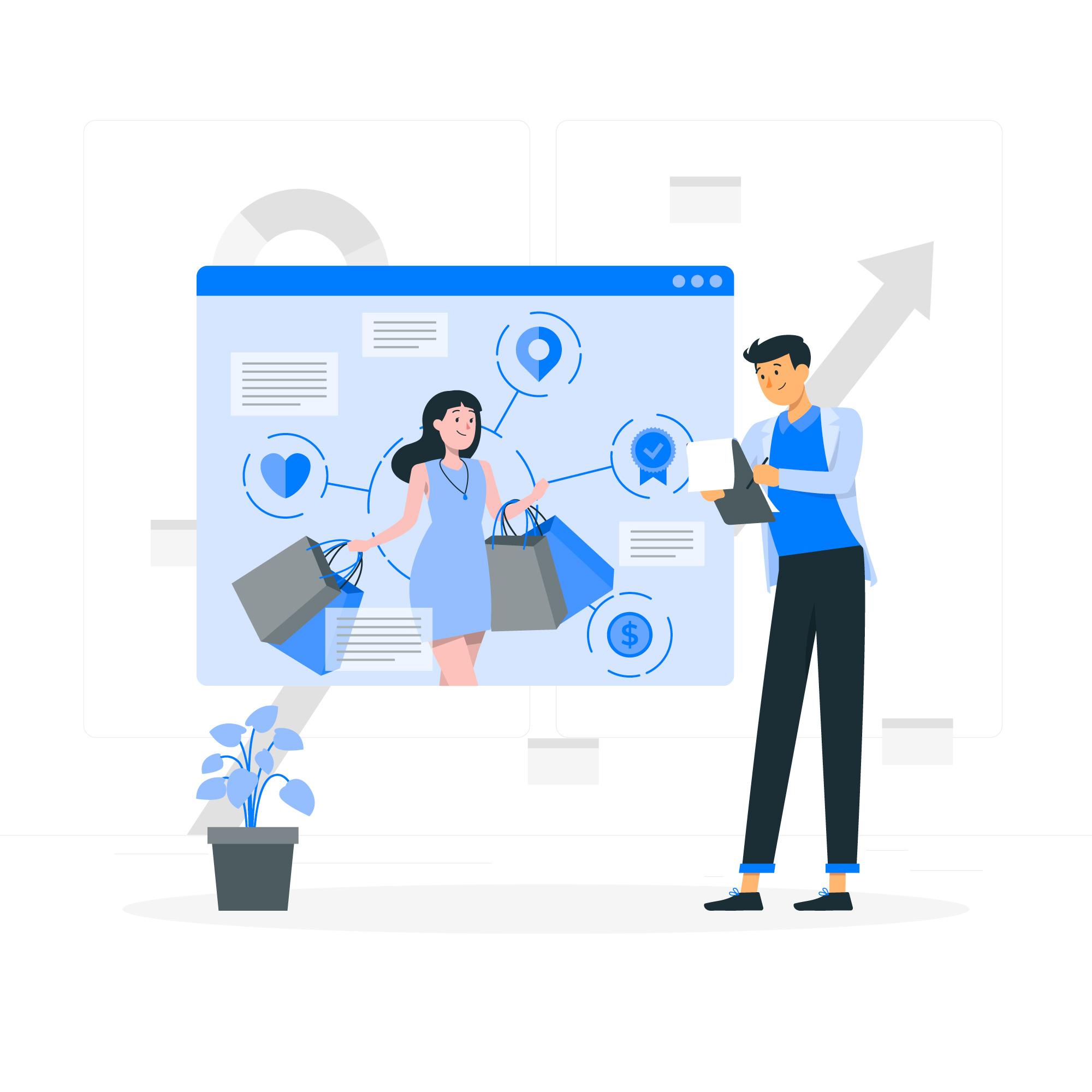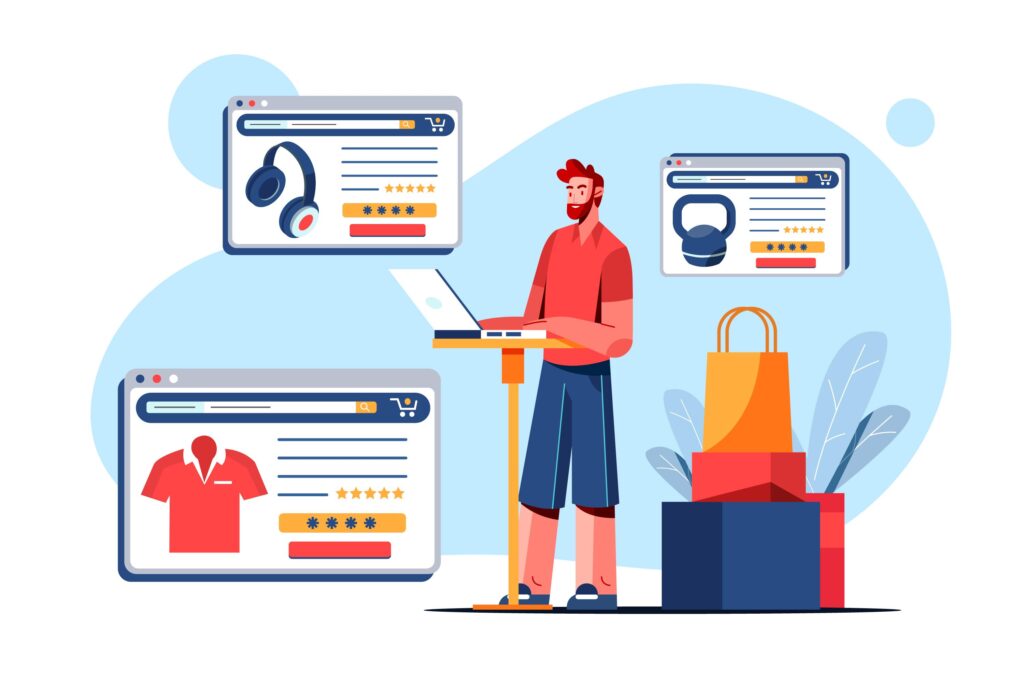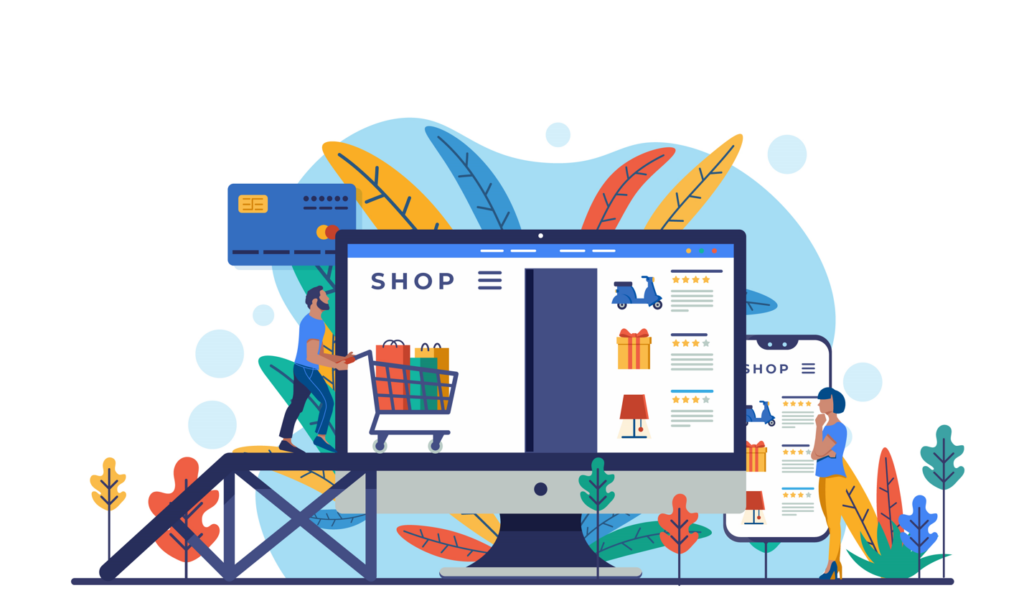
Key Takeaways
- E-commerce personalization elevates sales, minimizes cart abandonment, enhances experience, boosts conversion rates, and nurtures customer loyalty.
- Effective personalization strategy involves data collection, segmentation, personalized recommendations, dynamic content, and behavioral triggers.
- AI drives personalization with data analysis, predictive insights, natural language processing, chatbots, pricing adaptation & many more.
- Industry leaders like Amazon, Netflix, and Spotify demonstrate success through personalized features, driving engagement and loyalty.
- Embracing personalization in e-commerce amplifies customer engagement, conversions, and loyalty, setting businesses ahead in the competitive landscape.
Personalization has become the secret sauce for success in the fast-paced realm of eCommerce.
No longer can businesses afford to treat customers as one homogeneous group.
By tailoring the shopping experience to each individual, personalization unlocks the power to increase customer engagement and foster long-term loyalty.
Today, eCommerce businesses must tap into the wealth of customer data available to understand their preferences and behaviors truly.
Armed with this knowledge, they can create unique and unforgettable experiences that resonate with customers personally.
From personalized product recommendations to tailored website content and seamless mobile experiences, personalization holds the key to higher conversion rates, repeat purchases, and a tribe of loyal brand advocates.
Using AI and real-life examples, this guide will explore why eCommerce personalization is essential.
So, get ready to revolutionize your eCommerce approach and embark on a journey to transform customer engagement and retention through the power of personalization.
What is Ecommerce personalization?

E-commerce personalization is all about creating a tailored and engaging online shopping experience.
By using customer data and advanced technologies, businesses can offer personalized product recommendations, customized content, and targeted marketing messages.
It’s about understanding individual preferences and delivering a customized shopping experience for each customer.
With e-commerce personalization, businesses can boost conversions, satisfaction, and loyalty by making every interaction uniquely relevant.
Benefits of personalization in ecommerce
1. Higher sales
E-commerce personalization has a direct impact on sales.
Businesses can drive impulse purchases by tailoring product recommendations and offers to individual customers.
Personalized recommendations provide customers with relevant options they may have yet to discover otherwise, leading to increased conversion rates and higher revenue.
Additionally, personalization techniques such as cross-selling and upselling can be effectively utilized to suggest complementary or upgraded products, further driving sales and increasing average order value.
2. Reduced cart abandonment
Cart abandonment is a common challenge for e-commerce businesses.
However, personalized recommendations can help address this issue.
When customers receive personalized product suggestions that align with their preferences, it helps overcome hesitation and indecision.
By presenting relevant alternatives or complementary items, businesses can entice customers to complete their purchases and reduce cart abandonment rates.
E-commerce personalization also enables personalized cart abandonment recovery strategies, such as sending targeted emails with incentives to encourage customers to return and complete their purchases.
3. Enhanced customer experience
E-commerce personalization focuses on understanding and catering to individual customer preferences.
By analyzing customer data, such as browsing history, purchase behavior, and demographics, businesses can create personalized experiences that make customers feel valued and understood.
Analyzing an Android subscription history can provide insights into the types of services or apps a customer regularly uses and subscribes to.
Personalized product recommendations, tailored content, and customized offers enhance the overall customer experience, leading to higher engagement and satisfaction.
4. Increased conversion rates
Personalized e-commerce experiences have a direct impact on conversion rates.
Businesses can significantly increase the likelihood of conversion by presenting customers with relevant products and offers based on their interests and past behavior.
Customers who see products that align with their preferences are more likely to purchase.
This personalized approach minimizes the time and effort required for customers to find what they need, leading to higher conversion rates and ultimately driving more sales.
5. Improved customer loyalty
E-commerce personalization helps build stronger relationships between customers and brands.
Customers who receive personalized recommendations and offers feel a deeper connection with the brand and perceive it as more attentive to their needs.
This fosters a sense of loyalty and encourages repeat purchases.
By consistently delivering personalized experiences, businesses can strengthen customer loyalty, increase lifetime value, and drive sustainable growth.
6. Improved customer retention
Personalization plays a vital role in building strong, long-term relationships with customers.
Customers who receive personalized experiences that align with their preferences and needs feel valued and more likely to return for future purchases.
By consistently delivering relevant recommendations, customized content, and personalized communication, businesses can foster loyalty and turn customers into advocates who actively promote the brand to others.
Satisfied, loyal customers are also less likely to switch to competitors, ensuring a higher customer retention rate.
7. Competitive advantage
In a highly competitive e-commerce landscape, personalization provides a significant competitive advantage.
By tailoring experiences and recommendations, businesses differentiate themselves from competitors and create a unique value proposition.
Personalized experiences set a brand apart, attract customers, and foster customer loyalty.
In addition, as personalization becomes increasingly expected by customers, businesses that do not invest in personalization risk losing customers to competitors who offer more tailored experiences.
8. Data-driven insights
E-commerce personalization relies on collecting and analyzing customer data.
This data provides valuable insights into customer preferences, behavior patterns, and market trends.
By leveraging these insights, businesses can make data-driven decisions to optimize their product offerings, marketing campaigns, and overall e-commerce strategy.
The continuous feedback loop of data collection and analysis allows businesses to refine their personalization efforts and improve the effectiveness of their marketing initiatives.
How to optimize your eCommerce personalization strategy

1. Data collection
To optimize your e-commerce personalization strategy, gathering and analyzing customer data is crucial.
It includes capturing data points such as browsing behavior, purchase history, demographic information, and preferences.
You can gather valuable insights into individual customers and their unique preferences by implementing robust data collection processes and utilizing tools like website analytics, customer surveys, and tracking mechanisms.
2. Segmentation
Once you have collected customer data, the next step is to segment your customer base.
Segmenting customers involves grouping them based on shared characteristics, behaviors, or preferences.
You can tailor personalized experiences and recommendations to each group’s distinct needs and interests by categorizing customers into specific segments.
Effective segmentation can be based on factors such as demographic information, past purchase behavior, product preferences, or engagement levels.
3. Personalized product recommendations
One of the key elements of e-commerce personalization is providing personalized product recommendations.
Leveraging techniques like collaborative filtering, content-based filtering, or hybrid approaches, you can suggest products to customers based on their browsing and purchase history.
By analyzing data patterns and customer preferences, you can generate relevant and targeted recommendations that align with each customer’s tastes, increasing the chances of conversion and customer satisfaction.
4. Dynamic content
Customizing website content, landing pages, and emails based on each customer’s preferences is another vital aspect of optimizing e-commerce personalization.
You can create unique and tailored experiences for individual customers by utilizing dynamic content tools and personalization platforms.
This involves displaying relevant product recommendations, adapting website layouts, showcasing personalized offers, and delivering targeted messaging based on customer data.
The goal is to increase engagement, enhance relevance, and create a seamless and personalized user experience across all touchpoints.
5. Behavioral triggers
Utilizing real-time behavioral triggers is an effective way to optimize your e-commerce personalization strategy.
By setting up automated triggers based on customer actions or events, you can prompt customers to take specific actions.
For example, sending cart abandonment emails with personalized offers or reminders can encourage customers to complete their purchase.
Similarly, triggering personalized recommendations or previous purchases can drive immediate engagement and increase the likelihood of conversion.
Real-time triggers allow you to capture customer attention at critical moments and provide timely and relevant interactions.
6. A/B testing and iteration
To optimize your e-commerce personalization strategy, adopting a continuous improvement mindset is essential.
Implement A/B testing to experiment with personalization techniques, content variations, and recommendation algorithms.
By testing and measuring the effectiveness of different approaches, you can iterate and refine your personalization strategy over time.
This iterative process ensures that you constantly adapt and optimize your e-commerce personalization efforts to deliver the best possible outcomes.
7. Monitoring and analytics
Regularly monitor the performance and impact of your personalization efforts through robust analytics and tracking mechanisms.
Analyze key metrics such as conversion rates, customer engagement, average order value, and customer satisfaction.
By gaining insights into the effectiveness of your personalization strategy, you can identify areas for improvement and make data-driven decisions to enhance the overall customer experience and drive better results.
8. Integration of AI and machine learning
To further optimize your e-commerce personalization strategy, consider integrating AI and machine learning technologies.
AI-powered algorithms can analyze vast amounts of customer data, identify patterns, and make real-time recommendations based on individual preferences.
By leveraging AI, you can automate and scale your personalization efforts, ensuring accurate and relevant experiences for each customer.
The role of AI in eCommerce personalization

1. Advanced data analysis
AI plays a critical role in analyzing large volumes of customer data in real-time.
By utilizing machine learning algorithms, AI can identify patterns, correlations, and trends within the data that human analysis might miss.
This enables businesses to gain deeper insights into customer preferences, behavior, and purchase patterns, leading to more accurate and effective personalization strategies.
2. Predictive analytics
AI-powered predictive models leverage historical data and machine learning algorithms to anticipate customer preferences and behaviors.
By analyzing past interactions, purchase history, browsing behavior, and demographic information.
AI can make accurate predictions about what products or offers a customer is likely to be interested in.
This allows businesses to deliver personalized experiences in real time.
It ensures that customers are presented with relevant recommendations and tailored content that align with their individual preferences.
3. Natural language processing
AI-powered natural language processing (NLP) techniques enable businesses to analyze and understand customer feedback and interactions at scale.
By using NLP algorithms, AI can interpret customer sentiment, identify key topics, and extract meaningful insights from customer reviews, social media posts, and support inquiries.
This understanding of customer sentiment and preferences allows businesses to respond with personalized messages, improve customer service, and address individual needs effectively.
4. Chatbots and virtual assistants
AI-powered chatbots and virtual assistants provide personalized assistance to customers, enhancing their overall shopping experience.
These intelligent virtual AI agents can engage in natural language conversations, answer customer queries, and provide product recommendations based on individual needs and preferences.
AI chatbots can also utilize customer data to offer personalized promotions, help with order tracking, and provide real-time support, improving customer satisfaction and driving conversions.
5. Personalized pricing and offers
AI algorithms can analyze customer data, market trends, and pricing strategies to dynamically adjust prices and offer personalized discounts or promotions.
By leveraging AI, businesses can optimize pricing strategies for individual customers, considering factors such as purchasing history, browsing behavior, and price sensitivity.
This personalized pricing approach enhances customer perception, increases purchase likelihood, and fosters customer loyalty.
6. Dynamic website personalization
AI-powered algorithms enable dynamic website personalization, where content, product recommendations, and user interfaces are customized based on individual preferences and behaviors.
By analyzing customer data in real-time, AI can adapt the website layout, display personalized content, and showcase relevant product recommendations that align with each visitor’s interests.
This dynamic personalization creates a more engaging and tailored experience, increasing customer satisfaction and driving conversions.
7. Omnichannel personalization
AI helps businesses deliver consistent and personalized experiences across multiple channels, including websites, mobile apps, social media, and offline interactions.
By integrating AI-powered personalization across various touchpoints, businesses can create a seamless and cohesive customer journey.
This ensures that customers receive consistent recommendations, customized messaging, and personalized offers regardless of the channel they interact with, resulting in a more unified and satisfying customer experience.
8. Continuous learning and optimization
AI-powered personalization systems have the ability to continuously learn and improve over time.
By analyzing customer interactions and feedback, AI algorithms can adapt and optimize the personalization strategy based on new data.
This iterative learning process allows businesses to refine their personalization efforts, stay up-to-date with changing customer preferences, and ensure that the personalized experiences provided are always relevant and valuable.
Ecommerce personalization examples
1. Amazon’s : Customers who bought this also bought

Amazon employs a highly effective personalized recommendation feature that suggests products to customers based on their browsing and purchase history.
By analyzing user behavior and preferences, Amazon’s recommendation algorithm identifies items that are commonly purchased together, increasing cross-selling opportunities.
This personalized approach not only enhances the customer’s shopping experience but also drives additional sales for the platform.
2. Netflix’s : Personalized content recommendations

Netflix leverages advanced algorithms and machine learning to provide personalized movie and TV show suggestions to its users.
By analyzing viewing patterns, genres, ratings, and user preferences, Netflix creates customized content recommendations for everyone.
This personalization strategy enables users to discover new content that aligns with their interests, resulting in a more engaging and enjoyable entertainment experience.
3. Spotify’s : Personalized playlists

Spotify utilizes data-driven personalization to curate customized playlists for its users.
By analyzing a user’s music taste, listening history, and preferences, Spotify creates personalized playlists tailored to each individual’s musical preferences.
These playlists may include recommended songs, similar artists, and curated collections based on the user’s unique music preferences.
This personalized approach enhances the user’s music discovery, creating a more immersive and enjoyable music streaming experience.
Conclusion
Personalization is the key to success in eCommerce marketing.
By leveraging customer data and advanced technologies, businesses can create tailored experiences that engage customers, increase conversions, and foster loyalty.
Examples from industry leaders like Amazon, Netflix, and Spotify showcase the power of personalization in driving customer satisfaction and revenue.
Don’t miss out on the opportunity to deliver exceptional experiences and stand out in the competitive eCommerce landscape.
Embrace personalization and watch your business thrive.
